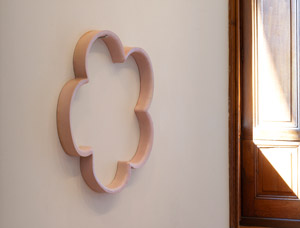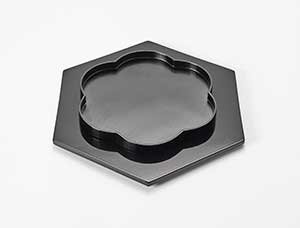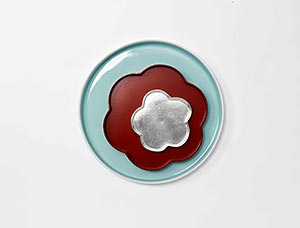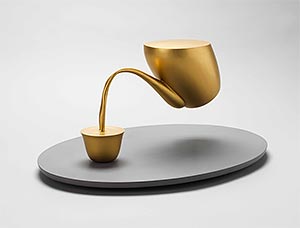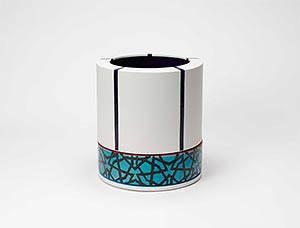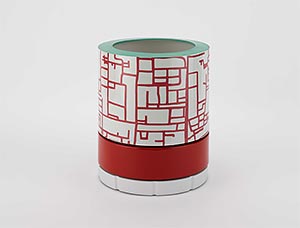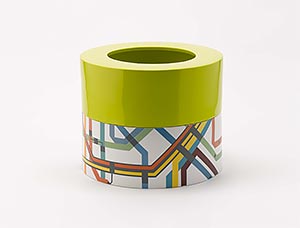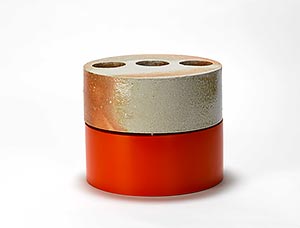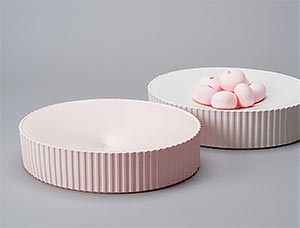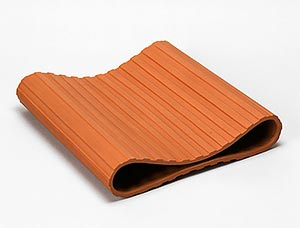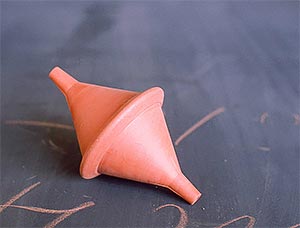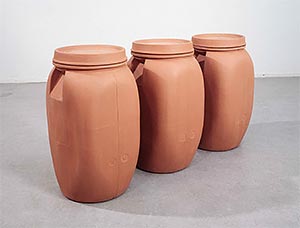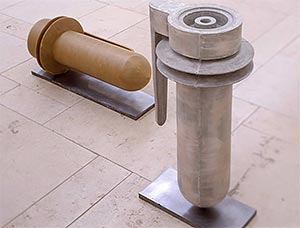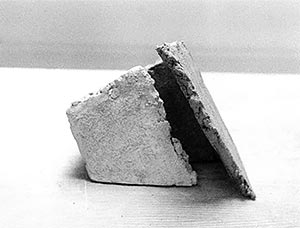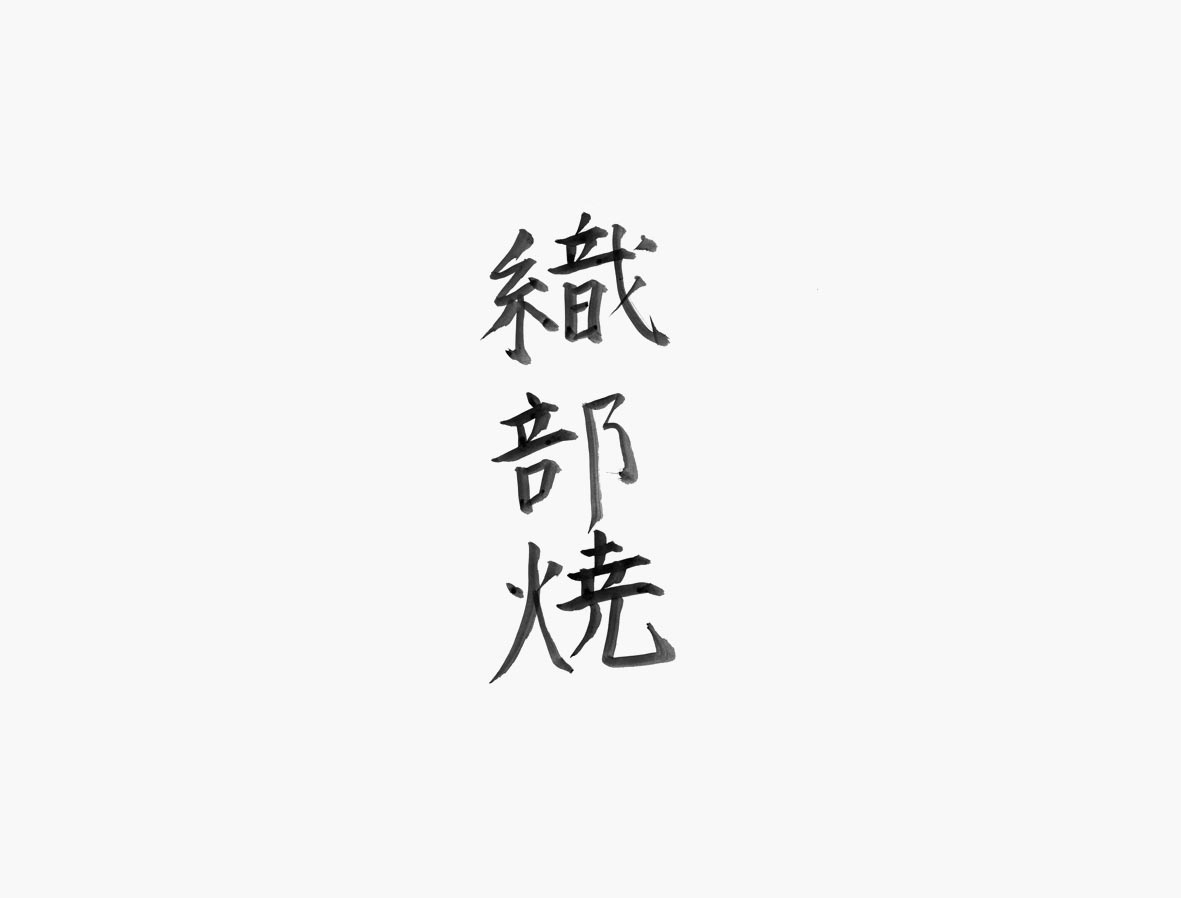
Oribe Ceramic | 2013–2014
Artist in residence
Seto, Japan | 1.7. to 19.8.2013
01.07.2013 | 8:35 a.m.
Arrived in Nagoya; after a twelve hour flight, three films in English, five meals and two snacks I am in Japan.
This is my second stay as artist in residence in this potters’ paradise, in which it seems every Japanese, man or woman, is a connoisseur.
Over the next seven weeks I want to devise a number of vessels that amount to contemporary interpretations of historical Oribe ceramics. What does that mean? As a rule ceramic vessels have a set function, but they also always obey certain aesthetic principles. And particularly for ceramics these are rooted in the particular region. «Interpretation» as I understand it is a systematic inquiry into form, configuration, design, appearance and coloration. My form-bound response reflects the relationship between history and contemporaneity.
10:00 a.m.
Arrive in Seto. About 20 people were waiting to welcome me in front of the Cultural Center. Three flags were flying, the Japanese, the local one from Seto, and the Swiss flag. My arrival was documented by a lot of photographs, and following the outdoor shots we went inside the Center to the office and were served green tea. There at the long table we met up again amid the national colours of Japan and Switzerland, this time in the shape of two pennants. Eight members of the Cultural Center of various rank took part in the reception. The only people to address me directly were the director, Hattori-san, and Matsudaira-san, the curator and interpreter who is looking after me. A map of Switzerland spread out on the table helped give a more visual cast to the formal exchanges. After a very relaxed discussion it was time for business. I was asked to read and sign my contract. This laid down which costs were covered by the Center and what performances I had to provide: the crux of the contract was that two or three of the ceramics that I was going to make in Seto were to go the museum at the Center. The direction would be free to make its choice. The contract was solemnly sealed with a rubber stamp.
That afternoon I entered the studio accompanied by Matsudaira-san and the chauffeur. A large number of studio heads, assistants and ceramicists were already awaiting us. Three of them were assigned to me as -assistants, Kato-san, Kuwabara-san, and Ito-san: I was surprised, for I hadn’t expected to receive such broad -support. The enthusiasm of my assistants is infectious, but I still feel too tired to start work right away.
02.07.2013 | 10:00 a.m.
The small Seto Ceramics and Glass Art Center has two spacious, well-equipped studios for ceramics and glass. Every summer and winter two artists are invited. This summer I have been chosen alongside the Mexican glass artist Hector M. Flores. The Center provides training and advanced courses for young ceramicists. Seto is one of the key locations in Japanese ceramics culture. This cultural heritage is not only fostered at the Center, but brought to public awareness and passed on.
Full of anticipation we stood there with twenty other ceramicists in the studio. I went into the firing room with its three electric kilns and two gas kilns, the heart of every ceramics studio. Their capacity lies between 0.5 and 2 -cubic metres. I am thrilled by the size of the kiln trays. Here I will be able to realise flat dishes up to 40 cm in diameter.
The kilns reach a temperature of 1300 degrees Celsius. That is normal and quite adequate for my purposes.
03.07.2013 | 8.00 p.m.
The museums in the vicinity gave me my first opportunity to see original Oribe ceramics.
Digression:
What is termed Oribe ceramic goes back to the end of the 16th/beginning of the 17th century. The name comes from Furuta Oribe (1543/44 –1615), a tea master and samurai whose aesthetic principles made him the leading figure in a new ceramics tradition. Oribe ceramics are marked by geometrical shapes and innovative designs inspired by textiles, as well as by the inclusion of written characters as decorative elements. A distinction is made in Oribe ceramics, according to the colour of the glaze, between black and green Oribe. Viewers today find these pieces of pottery incredibly fresh and modern with their dynamic structures, strongly contrasting fields of colour and geometrical forms, and their decorative elements.
04.07.2013 | 10:00 a.m.
I have commenced my practical researches by choosing three basic forms: the circle, the square and the hexagon.
I have assigned translucent porcelain and a half-gloss celadon glaze to the circle. For the square I have selec---ted a local stoneware clay and a green Oribe glaze. The hexagon will be done in another local stoneware clay and finished with a matt black Oribe glaze. In long series of experiments I cast, form and fire each of the basic forms using different techniques and clays from the region. Countless trial plaques are being cast in every variation of green and black glazes, while light blue celadon glazes are being tested on the translucent porcelain clay. In my conversations with my assistants, the head of the Center and befriended ceramicists, I enter into deep discussions about the typical horizontal Japanese forms and the outcome of the trial pieces done with repeated firing.
13.07.2013 | 10:00 p.m.
I came to Seto with a selection of tools. At the end of the day today my assistant lost a small item from my plaster-working tools while cleaning and tidying the workplace. We tried to find it, but in vain. It was not a problem for me and I calmed her down before we made our joint way home.
14.07.2013 | 10:00 a.m.
Today is Kuwabara-san’s one free day in the week. I -already suspect the worst. And it is as I imagine. She walks up to me in the studio, beaming, and hands me the missing piece, before going back home. Why do I relate this? As I experience it the atmosphere at the Center is extremely cheerful. The employees are completely behind their employers. Sometimes the director will even bring ice cream for everybody, and the vice-director even repairs the air conditioner or mows the lawn. And everywhere you can sense this deep urge to produce top -results.
The trial glazes that we took from the kiln today look highly promising.
15.07.2013 | 8:00 a.m
All of the bowls that I have cast to date in porcelain have cracked. Why is that?
15/16.07.2013 | 10:00 a.m.
I discuss the flaws with the studio heads and my assistants. The Japanese porcelain clays have a wonderful, white tone, but as it was explained to me they are extremely capricious. So there is nothing left for it but to cast another dozen bowls and to perfect myself in this way of working, which I am in fact very familiar with.
24.07.2013 | 9:00 a.m.
I have decided to enlarge my set, which originally was to consist of just three pieces. My concept now involves having two wooden bowls made in different colours and shaped like a symmetrical flower, and two wooden bowls done as hexagons, because the so-called Oribe style also involves lacquerwork. The Urushi master Nishimura Kei (Keikou Nishimura Urushi Art Studio) will do them from my drawings, lacquered in a dark red (Kakuchi) and in the traditional black and green Oribe colours. But first he will produce a couple of trial pieces for me. I can pick them up at his studio on my next visit to Kyoto in a week’s time. The floral motifs present me with a lot of difficulties.
30.07.2013 | 8:00 p.m.
The rhythm of work at the Center is very intense. Everyone works from Wednesday to Monday. Tuesday though is for outings. On 09.07. we drove with Matsudaira-san and the vice-director Kato-san from the Cultural Center to Sanshu Asuke Yashiki. This is a kind of open air museum situated close to Toyota, about 35 km from the Center. The buildings in the grounds are thatched in the old style with rice straw and each is home to a particular traditional craft, from plaiting straw sandals to paper making. The opening sequence from Akira Kurosawa’s The Seven Samurai runs across my mind, with its view of the little rural village.
While visiting Kyoto today I came across a box of rakugan (sugar blossoms). At last I have found my floral motif. I have placed the little box next to my bed.
31.07.2013 | 10.00 a.m.
I select the peach blossom from the pink-coloured box and enlarge it. The next step is making the mould. There is no longer enough time to have the porcelain form for the blossom made in Seto. The silver glaze I have chosen is unknown territory to me. With a lot of patience and a smile, my team explains the technical challenges posed by this finish. I write it all down in my kiln diary.
10.08.2013 | 8:00 p.m.
I have made the final choice for the decor on my black Oribe plates. I have taken sections from the finely detailed designs on select but representative historic Oribe ceramics and greatly enlarged them. I have dispensed with traditional viewing sides in favour of an overall look.
14.08.2013 | 10:00 a.m.
Today is firing day. Almost the entire set disappears into the kilns, so if anything goes wrong now I’ll be returning home empty-handed!
16.08.2013 | 10:00 a.m.
The kilns have proved gracious. Half of the green bowls are a real gift with their immaculate surfaces and powerful colour contrasts. The black plates are a perfect success. But there is brown fogging on the celadon coloured bowls. I talked it over with the director and assistants and we analysed the results. They at once offered to cast and fire the bowls again after my departure and to send them to me in Bern.
17.08.2013 | 2:00 p.m.
Hattari-san and Matsudaira-san are making their selection today at the Museum. An important moment after almost two months of intensive labour in Seto. I cautiously suggest that they choose a complete set of my work, rounded off by one of the wooden bowls lacquered by Nishimura-san and the little silver dish I have yet to make. My suggestion is accepted with smiles. I am delighted that the group has turned out so well.
18.08.2013 | 6:00 p.m.
A farewell party is being given for me today. Everyone comes together once again to bid me farewell. We have a last chance to exchange thoughts over an excellent buffet. We have worked, lived and discussed with one another for almost seven weeks now. It was an intense and joyful time. The success of my work is also due to a considerable extent to my team in Seto.
19.08.2016 | 07:00 a.m.
The director, Matsudaira-san and the chauffeur take me to the airport. I join the queue to check in. They wait until I disappear behind the barriers. A last wave ... Sayonara.
24.08. – 30.10.2013
Back in Bern I now cast the silver blossom. During the third firing the glazed dish is finished with the shiny silver metal and fired at 750 degrees. The oral instructions I received in Seto prove more difficult to carry out than I envisaged. My first attempt fails miserably; the silver has not covered the surface properly, so the white porcelain shines through from beneath. A number of spoils prompt me to solve the problem via e-mail with the studio heads Yasumin-san and Matsudaira-san. After receiving lengthy advice and doing long series of tests, I finally succeed in applying the silver in the correct thickness.
As promised, I send the small silver dish to Seto. The set will be put on show on 01. February 2014 in the Exhibition of Invited Artists.
10.12.2013 | 4:00 p.m.
Post from Seto. I open the first of the three large packets, the bubble wrap is a nuisance, but shining out from the white tissue paper is the translucent celadon (...).
Margareta Daepp and Susanne Schneemann
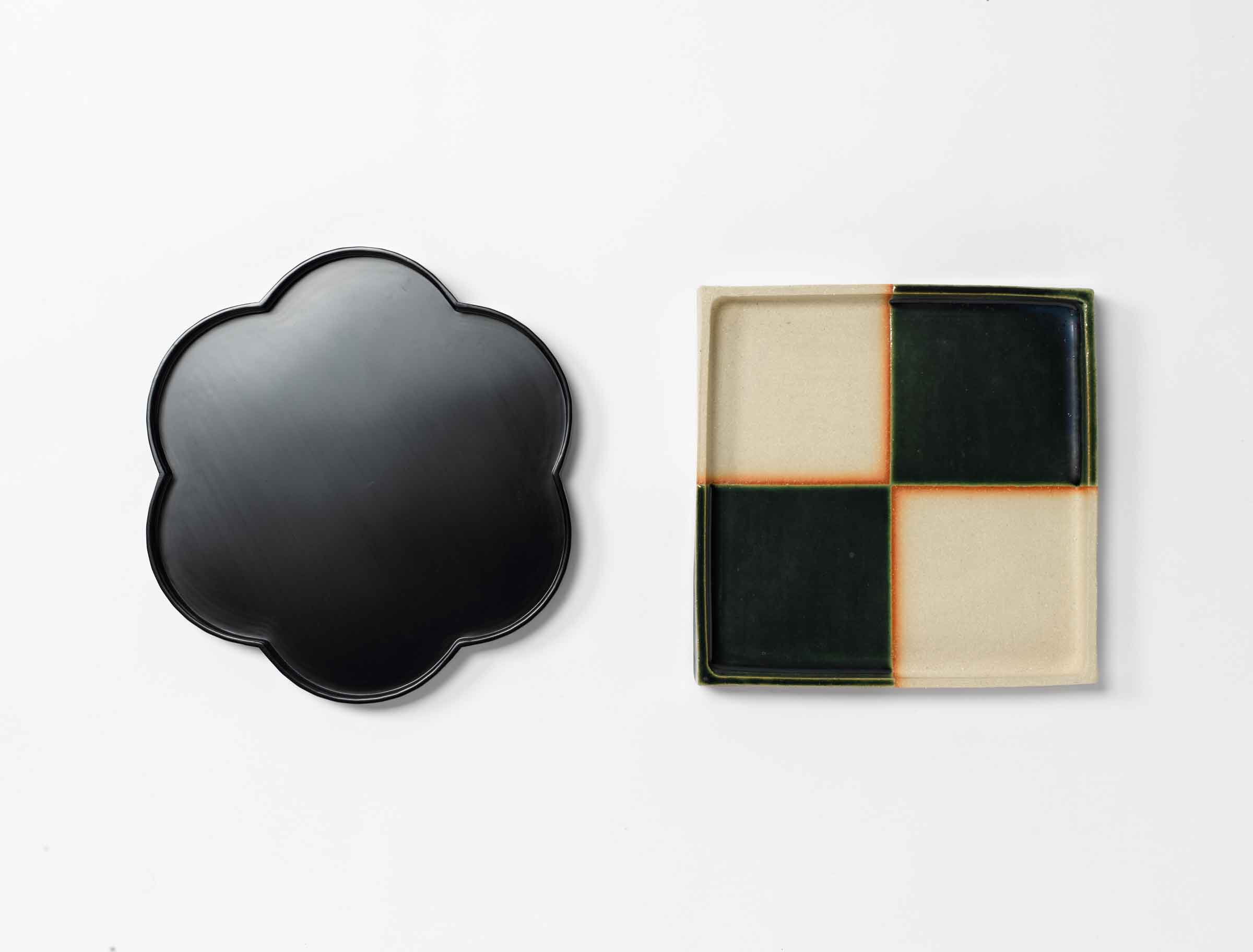
Set Black
2014 | Square: stoneware clay with green Oribe glaze — Flower: wood with black Urushi lacquer | Ø 26cm, h 2.1 cm
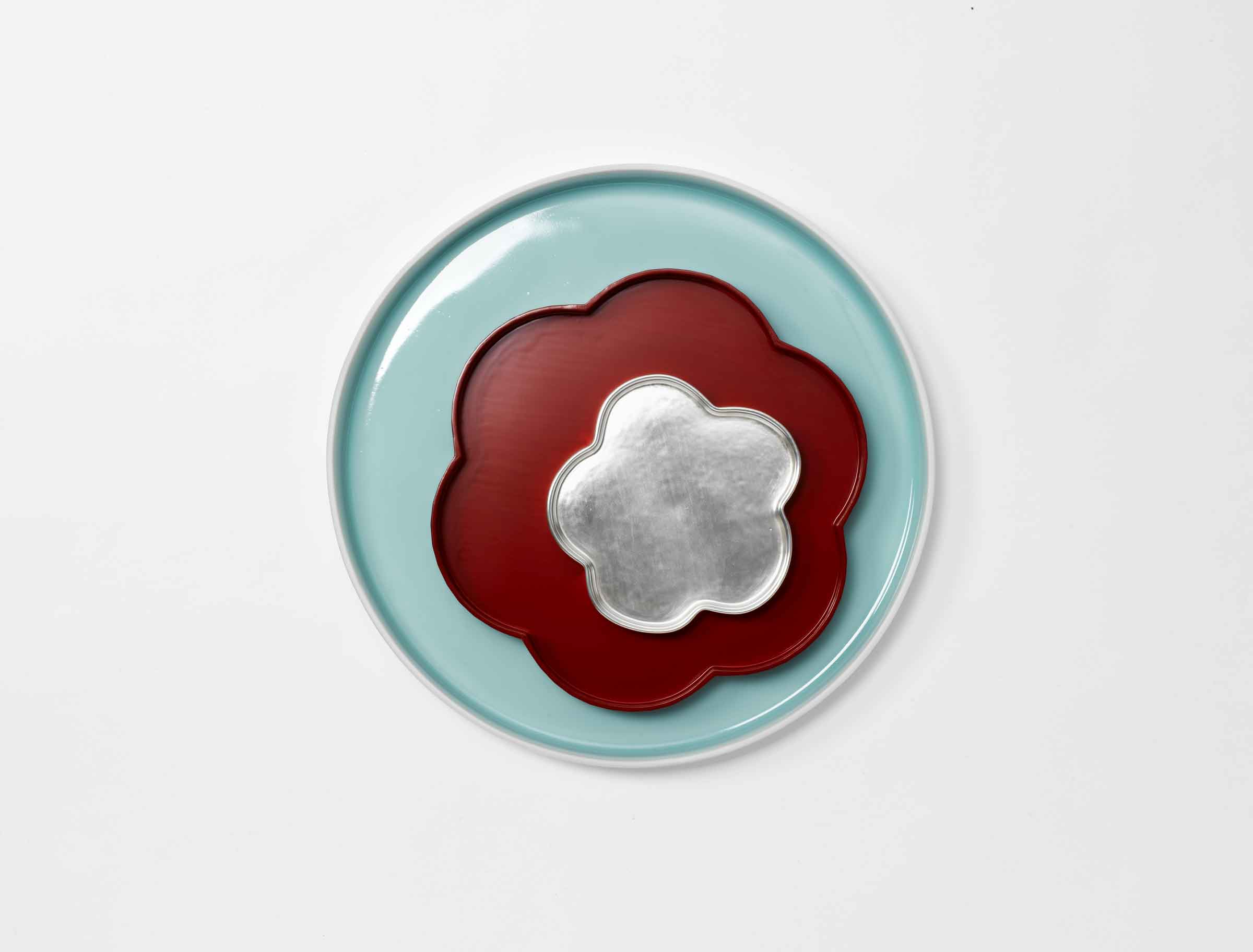
Set Red Flower
2014 | Circle: porcelain with celadon glaze | Ø 35.5cm, h 2.6cm — Flower: wood with dark red Urushi lacquer | Ø 26cm, h 2.1cm — Blossom: porcelain with silver glaze | Ø 15.3cm, h 1.4cm
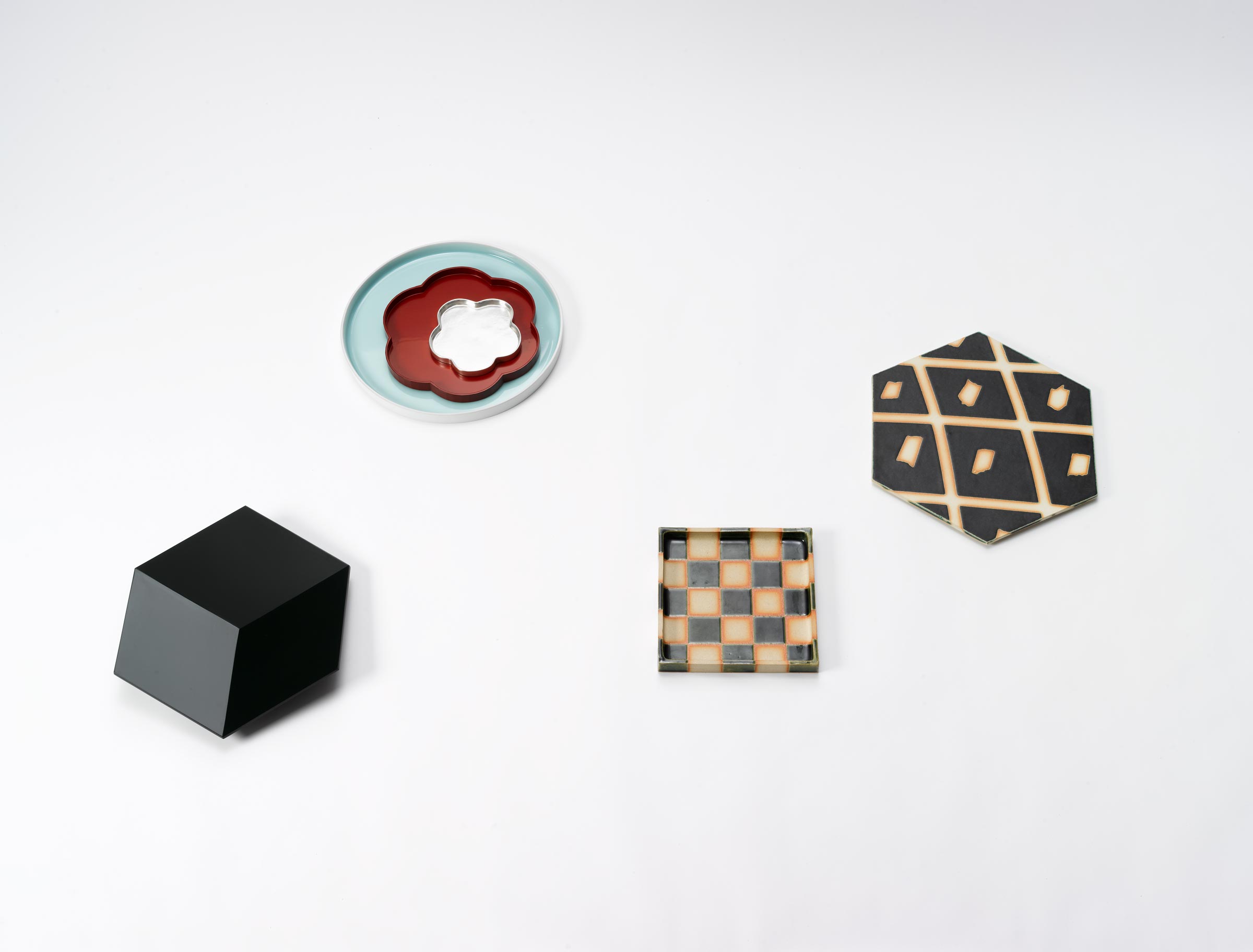
Set Big Dark Green
2014 | Hexagon 1: wood with dark green Urushi lacquer | 30.8 x 35.7cm, h 6cm — Circle: porcelain with celadon glaze | Ø 35.5cm, h 2.6cm — Flower: wood with dark red Urushi lacquer | Ø 26cm, h 2.1cm — Blossom: porcelain with silver glaze | Ø 15.3cm, h 1.4cm — Square: stoneware clay with green Oribe glaze | 22.8 x 22.8cm, h 3cm — Hexagon 2: stoneware clay with black Oribe glaze | 34.2 x 39.5cm, h 1.5cm
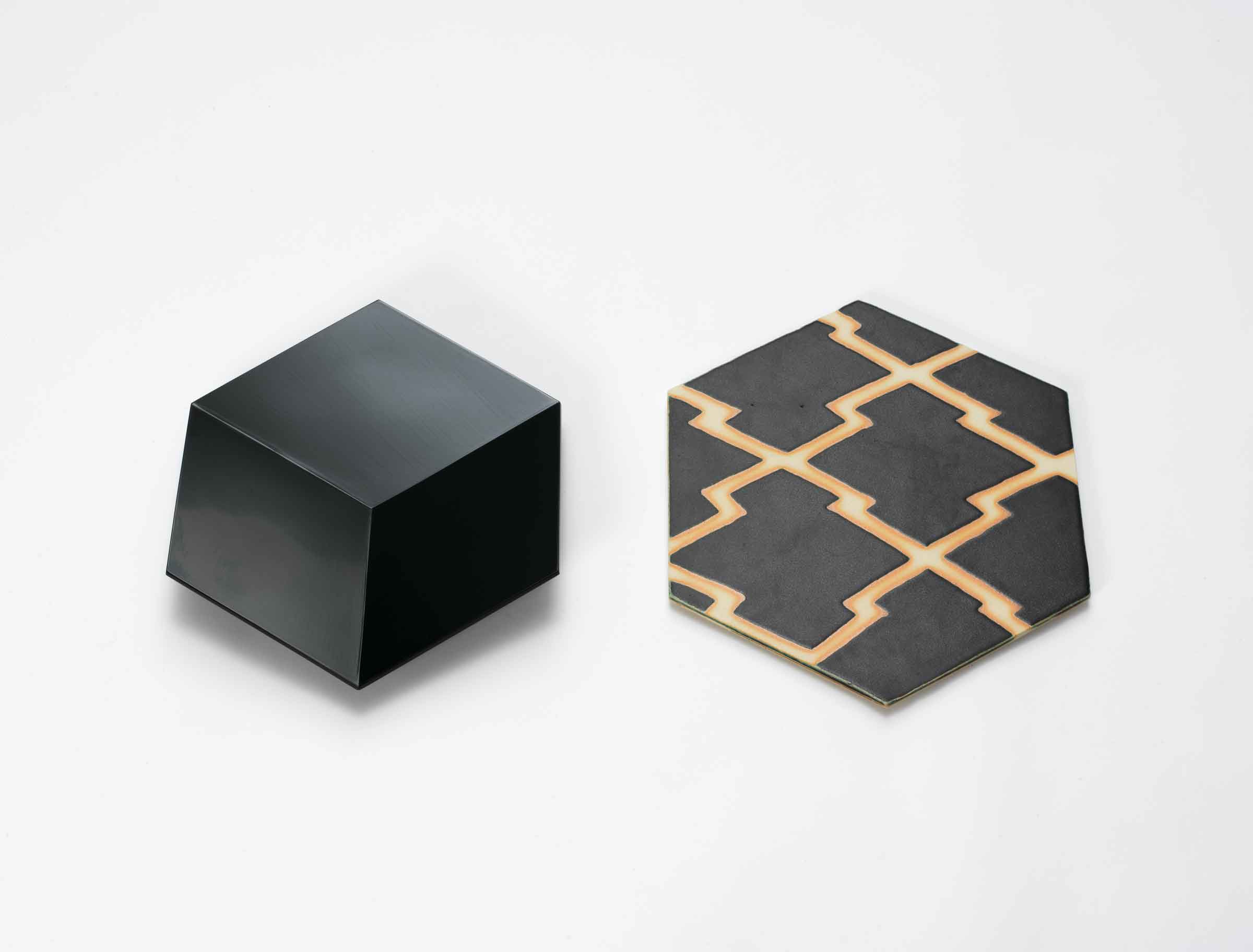
Set Dark Green
2014 | Hexagon 1: wood with dark green Urushi lacquer | 30.8 x 35.7cm, h 6cm — Hexagon 2: stoneware clay with black Oribe glaze | 34.2 x 39.5cm, h 1.5cm
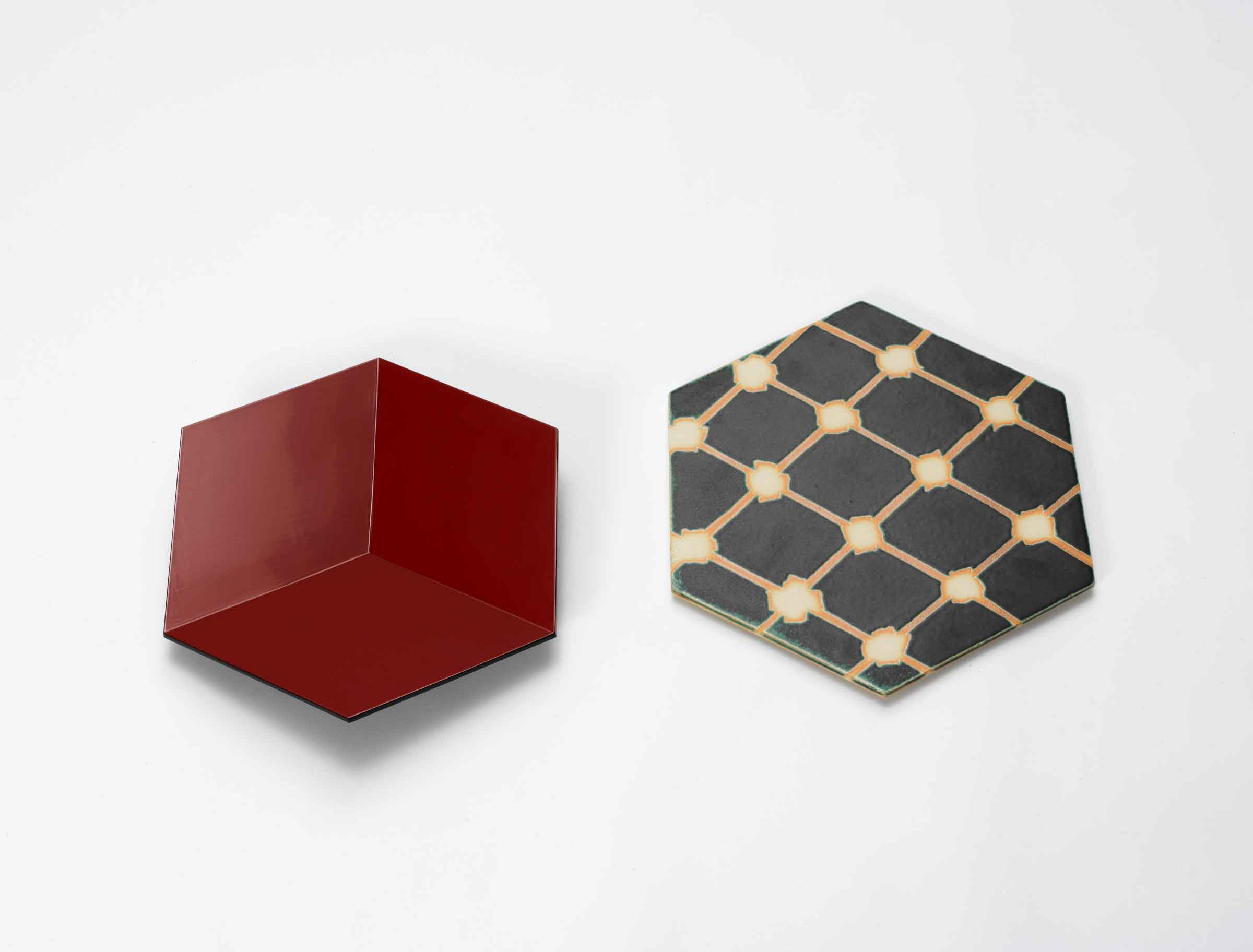
Set Red
2014 | Hexagon 1: wood with dark red Urushi lacquer | 30.8 x 35.7cm, h 6cm — Hexagon 2: stoneware clay with black Oribe glaze | 34.2 x 39.5cm, h 1.5cm
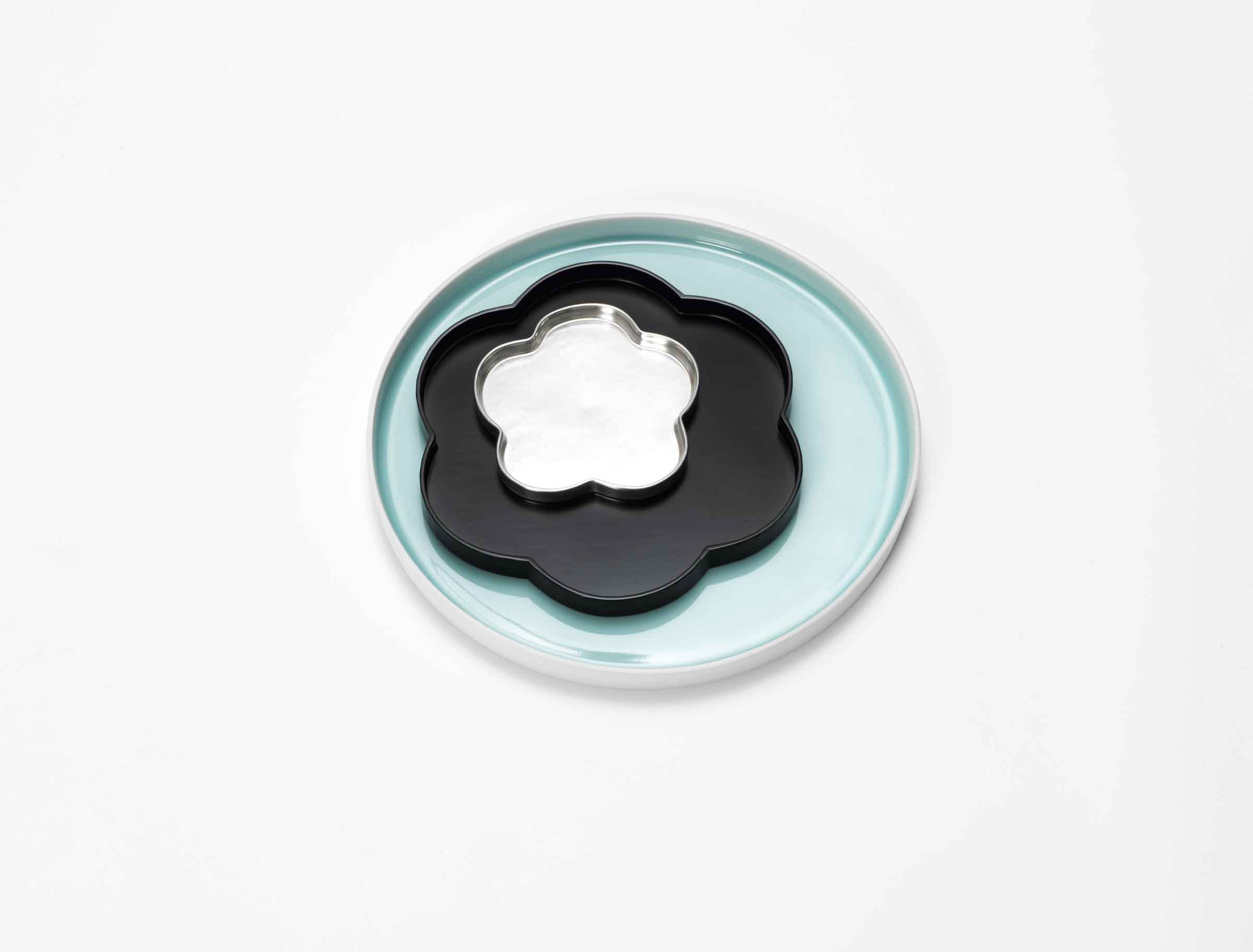
Set Black Flower
2014 | Circle: porcelain with celadon glaze | Ø 35.5cm, h 2.6cm — Flower: wood with black Urushi lacquer | Ø 26cm, h 2.1cm — Blossom: porcelain with silver glaze | Ø 15.3cm, h 1.4cm
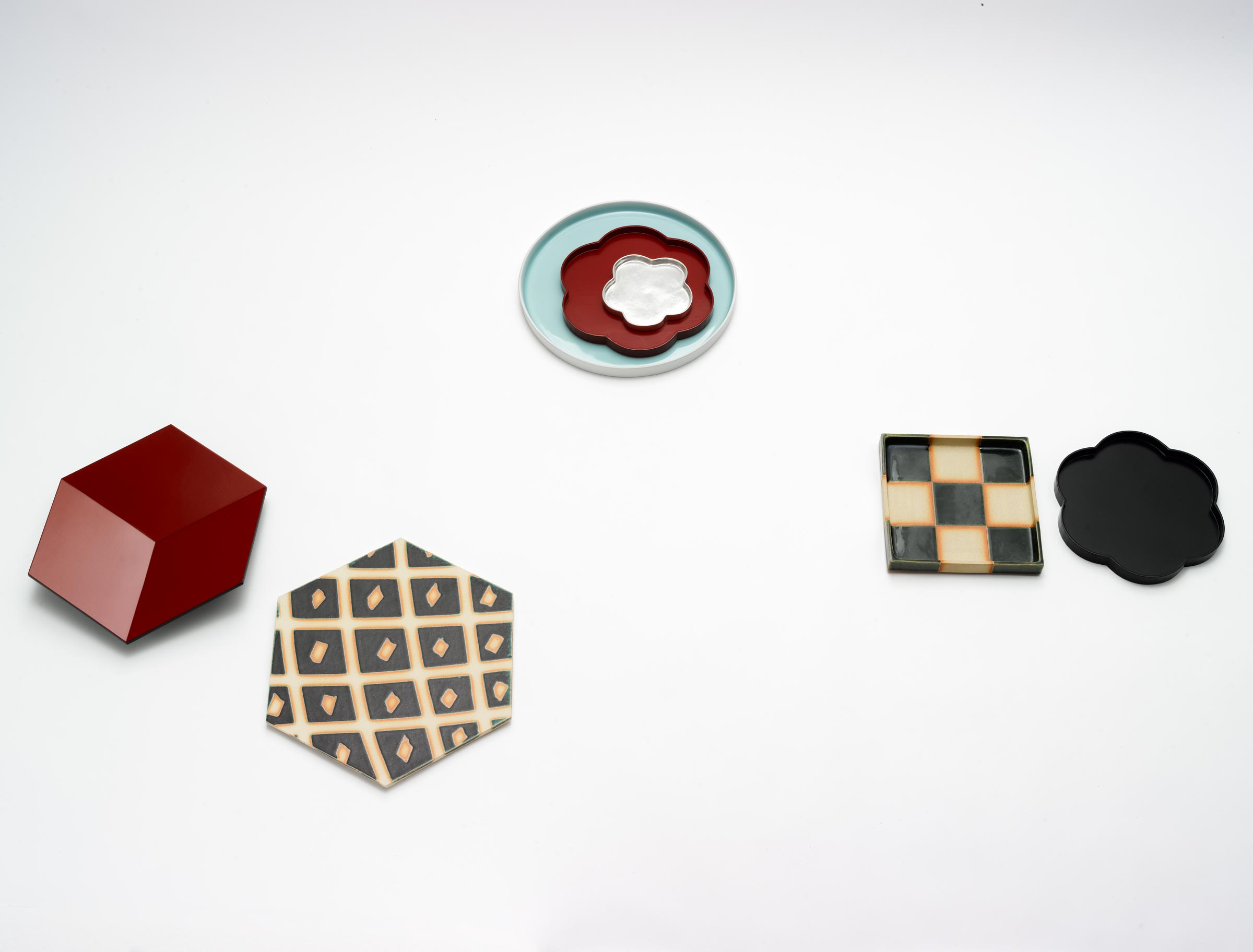
Set Big Red
2014 | Hexagon 1: wood with dark red Urushi lacquer | 30.8 x 35.7 cm, h 6cm — Hexagon 2: stoneware clay with black Oribe glaze | 34.2 x 39.5cm, h 1.5cm — Circle: porcelain with celadon glaze | Ø 35.5cm, h 2.6cm — Flower: wood with dark red Urushi lacquer | Ø 26cm, h 2.1cm — Blossom: porcelain with silver glaze | Ø 15.3cm, h 1.4cm — Square: stoneware clay with green Oribe glaze | 22.8 x 22.8cm, h 3cm — Flower: wood with black Urushi lacquer | Ø 26cm, h 2.1cm
